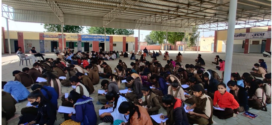The dominant model of higher education at the bachelor’s level in India is one in which students select their program of study ahead of time (mechanical engineering, or history, or psychology, for example), and then spend the next three or four years almost exclusively studying various subjects associated with their program.
Although this model serves some students well, for the vast majority, there are some clear downsides. The biggest is that a student coming in to college at the age of eighteen really has no clear idea of where her interests lie. So she ends up choosing her program of study based on various factors extraneous to her, such as her parents’ preferences, or society’s expectations, or simply, the availability of a seat in a college. Only rarely does she select her field based on any prior knowledge or on genuine interest. Now, if she is lucky, she could end up liking the subject she has chosen. But just as likely, she could find it a mismatch, and she will be stuck with a bad choice.
Another major downside is that these degrees deny the student the opportunity to study a wide range of subjects that reflect the gamut of human thought and creativity. For instance, a student of science or engineering studies only subjects related to science and engineering, and is not exposed to the study of how societies are structured (sociology), how power is organized in societies (political science), what events define the past and how to interpret them in today’s context (history), and so on. Likewise, the student of history is not exposed to the sciences and to a reflection on how science affects her life now and how current scientific advances could drastically reshape her life in the future.
We all pay the price this for this, both individually as students and collectively as a society. At an individual level, the student can find herself stuck and may find herself spending an entire career in a field that does not excite her. Now imagine if that same student were exposed to a wide range of subjects and then allowed to study subjects that truly inspire her! How much more meaning her education would provide her! How much more comprehension she would have of different facets of human existence! How much more productive she would be! How much she could transform the world to our collective benefit!
Education at its best is the process of drawing out — getting the best out of a person, enabling her to reach her full potential. We can do this by exposing students to a wide range of learning, spanning several disciplines, and ensuring that a student makes a choice for deep study only after being exposed to different subjects.
The liberal arts education model, an alternative to our current model, does just that! In this model, the student is not expected to select her program of study when she enters college. Instead, early on, she studies an array of subjects spanning a range of human endeavor. After this, she selects an area to specialize in, and then studies subjects related this area. The early breadth is provided by courses in social studies (history, anthropology, politics and law, and so on), in the humanities and arts (literature and languages, philosophy, music, theater and other performing arts), in the natural sciences (physics, biology, evolution, climate science), and in mathematics and logic. She then goes on to focused study in one of these same subjects — and contrary to what the name “liberal arts” might suggest, she can focus on the sciences if she chooses.
There is more to this model besides choice and inter-disciplinarity. There is an emphasis on critical thinking, on speech and communication skills, and on developing an ethical framework and a personal world-view. The student is encouraged to reason for herself, to accept orthodoxies only after she has thought through them and found them in sync with her own world-view. This generates independence, well-roundedness, creativity and flexibility in the student, a must for our fast-changing times.
The National Education Policy that was adopted last year explicitly calls for undergraduate education “to break down harmful silos, enable students to become well-rounded across disciplines, including artistic, creative, and analytic subjects.” The report goes on to say “A holistic and multi-disciplinary education…is indeed what is needed for the education of India…” This is precisely what a liberal arts education provides!
Today’s hyper-specialized higher education model works well for a select body of students who already know what they want to pursue in life and are focused about it, but for the vast majority of students, and for society at large, the liberal arts model will be a better fit.
 Newspatrolling.com News cum Content Syndication Portal Online
Newspatrolling.com News cum Content Syndication Portal Online







